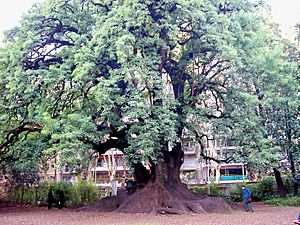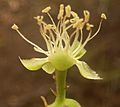Ombú facts for kids
Quick facts for kids Ombú |
|
|---|---|
 |
|
| A specimen, more than 80 years old, in Buenos Aires, Argentina | |
| Scientific classification | |
| Genus: |
Phytolacca
|
| Species: |
dioica
|
| Synonyms | |
|
Pircunia dioica Moq. |
|
The Ombú (scientific name: Phytolacca dioica) is a huge evergreen plant. It belongs to the Pokeweed Family (Phytolaccaceae). This amazing plant comes from the Pampas, which are grasslands in South America.
Contents
What is an Ombú?
The Ombú is often called a tree, but it's actually a very large herbaceous plant. This means its trunk is not made of true wood. Instead, it's soft and spongy. You can even cut it with a knife! This special trunk helps the Ombú grow very fast.
Size and Shape
The Ombú has a wide, umbrella-shaped top, called a canopy. This canopy can spread out 12 to 15 meters (40 to 50 feet) wide. The plant itself can grow 12 to 18 meters (40 to 60 feet) tall. Its upper part grows from a thick, root-like base called a caudex. This base can be as wide as 18 meters (60 feet)!
Flowers and Reproduction
Ombú plants are "dioecious." This means that male flowers and female flowers grow on separate plants. Butterflies, like the Doxocopa laurentia, help pollinate the flowers.
Special Features
The sap (liquid inside the plant) of the Ombú is poisonous. Because of this, farm animals like cattle do not eat it. It's also safe from pests like locusts. Sometimes, people use its leaves as a medicine, but only with great care because of its poisonous sap.
Uses and Symbolism
Because its trunk is soft and easy to shape, the Ombú is sometimes used in the art of bonsai. This is where small trees are grown in pots and shaped.
The Ombú is a very important symbol in Uruguay and Argentina. It represents the culture of the gauchos, who are South American cowboys. Its large canopy stands out from far away. It offers great comfort and shelter from the sun and rain.
Where it Grows
The Ombú is related to the pokeweed plant found in North America. People also grow Ombú in places like Southern California for shade. In South Africa, it is considered a minor invasive species. This means it can sometimes spread and grow where it's not native.
Gallery
-
Magenta petioles and leaf venation
-
Inflorescence and fruit
See also
 In Spanish: Ombú para niños
In Spanish: Ombú para niños





